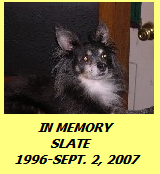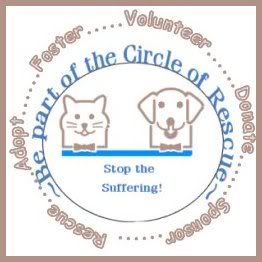The weekend turned out not to be too bad. I ended up sick for the second half of my weekend. Let's just say, intestinal distress. Anyway, I got up looking more than half dead to work at
yesterday. I still had a good time, but I was a bit held back by my illness, which leaves me looking forward to next Monday. We did work an incredible amount of dogs for a February. We didn't get to do any outside work, because of the horrible storms we were having yesterday. We managed to get them all in from the play yards and pens, right before the first pieces of hail were hitting the ground. Since I'm feeling a little green around the gills and not up to my usual self, I'm going to post a story of interest that
made mention of today. A really interesting look at the animal rescuers. Enjoy!:
Rescuing Fly
A journey on the dog underground railroad.
By Jon Katz
Posted Thursday, Feb. 17, 2005, at 8:03 AM PT
Most people would have driven by without slowing, but "Patsy Beckett" (a pseudonym) is a dog rescuer, so she noticed the young border collie tethered to a tree outside a Northern Florida farmhouse. Beckett made a point of passing the farm on her way to work the next day and for weeks thereafter. Each time, she saw the dog—whom she christened Fly—either sitting forlornly or straining at her rope. "She was a beautiful dog, very alert, keen," Patsy said. At one point, spotting a neighbor outside, she stopped and asked about the dog.
When Fly first arrived, the neighbor said, she was a playful, busy pup, but she bothered the farmer's cows and sheep and obsessively chased chickens, cars, and trucks.
Evidently, the farmer didn't realize that border collies aren't born knowing how to herd; it requires long, painstaking training before they'll go whizzing around on command. Pressed for time and money, farmers have little patience for creatures that have to be fed but can't be sold. But having paid $200 for Fly, the farmer figured he could at least use her as a watchdog. So, day and night, rain or shine, heat or cold, the dog lived out her life attached to a tree, barking and circling some of the time, lying down and staring at the road the rest.
The neighbor, disturbed by the sight, had actually called the police. But tethering was not illegal, the cops said. She was fed; she wasn't beaten; there was no crime.
Beckett made a few telephone calls. One night, when the farmer's truck was gone from his driveway, she and a friend from her rescue group parked their creaky Windstar on the highway out of sight, crept up and cut Fly's rope, and walked off with the startled but friendly dog. "You will never be treated this way again," Patsy promised her. A few hours later, Fly's collar was replaced, her tag destroyed, and her picture posted on a Yahoo mailing list about rescued dogs.
Fly's life had changed forever. She was now in one of the country's most interesting animal subcultures, the dog rescue system—a semi-underground network of devoted pet lovers willing to do practically anything to help neglected and abused dogs find good homes.
Type "Dog Rescue" into Google and you will get 4,650,000 hits. Nobody knows precisely how many people are involved in the rescue movement, but it's reasonable to assume there are tens of thousands, in every city and state. (If you doubt this, visit petfinder.org, one of the rescue culture's primary communications networks.)
Some rescue groups are highly organized, experienced, well-funded, nearly professional. Others are small amateur operations run out of garages and back yards. Their members may identify strongly with animals as victims, sometimes because of traumas and disappointments in their own lives. Others simply love animals and want to help them. Most participants are middle or working-class women, it appears. And since it's hard to rescue, treat, and re-home a dog without help, they're obsessive e-mailers and communicators. In fact, the growth of the phenomenon is closely tied to the digital age. The Internet has made every dog a potential national adoptee.
If Americans find themselves homeless, laid off, abused, or in need of urgent medical care, no van will pull up in their driveways to whisk them off for treatment, place them in temporary housing, then drive them around the country to find them appropriate new homes and visit them regularly to monitor their progress and make sure they're OK. With dogs, though, it happens every day.
As of this writing, Fly is in Virginia en route to upstate New York. More than a dozen people and groups have already been involved in her rescue. Fly spent her first couple of nights in a private home in Jacksonville, as messages seeking help and transport were posted on eBay and Yahoo mailing lists where rescuers congregate. There's even a secret Yahoo list that collects the names of dog abusers, so that rescue groups can avoid them as potential adopters. There were scores of responses to the Fly posting, from all over the country.
Next, a transporter with a minivan met Fly at a rest stop near Jacksonville and drove her to Atlanta. The well-funded rescue groups pay for gas and expenses, but most others can't. The woman who drove Fly, I learned, has spent thousands of her own dollars rescuing dogs and knows the cheapest vets, the most generous pet-supply stores, and the most vigorous animal-rights support groups along the East Coast.
In Atlanta, rescuers sought help from a friendly vet tech, one of many. The lowest-paid of veterinary office workers, techs collect urine and fecal samples, draw blood, work brutal hours, tend to sick animals overnight, and are often the most fervent animal lovers in a practice. (Many vets help rescued animals when they can. Rescuers are savvy about figuring out which vets waive or reduce fees for needy animals.)
The Atlanta tech treated Fly's rope-burn sores. Fly received medication for worms and fleas, and shots for rabies and distemper. A non-profit mobile veterinary service agreed to spay her for a rock-bottom $60.
A different transporter picked her up for the trek north to Charleston. Dog rescuers often know one another, sleep in their cars or on volunteers' sofas and guest beds, and hand off their charges in parks, fast food parking lots, malls, and motel parking lots. Another rescue specialist, known as a "fosterer," would keep Fly in her Charleston home for a couple of weeks, to settle her down, watch for health and behavioral problems, and evaluate her needs. Professional rescue groups never adopt out an aggressive or sick dog. Some of the smaller, amateur groups aren't as careful.
Constant travel can be traumatic for a dog, especially one who's never lived in a house or traveled in a car, but border collies like keeping busy. The canine underground railroad almost seemed fun for Fly, lots of things to see, an exciting turn in life devoid of activity. She was anxious, but she also enjoyed the treats, the attention, and the opportunity to chase balls and Frisbees. Nobody yelled at her. On the contrary, everybody loved her.
At each stop, messages describing her health and moods, the things that made her anxious, what she liked and what she didn't, and which diet was appropriate were posted online. A growing library on Fly was being assembled daily for her rescuers and, eventually, her new owner. Meanwhile, "re-homers" were grilling potential adopters, making sure the next home was the right one.
Fly was being reborn. Soon she would probably even get a new name. Patsy checked back with her friends in Florida. The farmer had not reported the dog missing to the police or local animal authorities. He seemed fine with the idea that she was gone, and he would never hear another word about her.
There is no universal pattern to the movement of rescued dogs, but many dogs move from the South to the Northeast. Spaying and neutering laws are reducing the number of adoptable dogs in cities like Boston and New York, and ideas about neutering and animal abuse are different in some parts of the rural South, say rescuers. There are more potential dog lovers with money in the North.
It's easy to see why dog rescue is a mushrooming culture. Turning a troubled person's life around is difficult, but rescuers with commitment and time and a few dollars can radically alter the fate of a dog. And there are millions of dogs—nearly 10 million in the shelter system, many others mistreated in private homes—in need of rescuing. We will not run out anytime soon. The fact that so many thousands of people devote themselves to this effort raises some important questions about our society's priorities, but there's no doubt it will continue.
Dog rescue remains a gamble, of course. For all the good will, hard work, and noble motivation, nobody can really predict with certainty how a traumatized, dislocated dog will respond in a new environment.
I will find out soon. Fly is doing nicely, I'm advised. She will arrive at her new home—my farm—later this month.
Jon Katz's is the author of The Dogs of Bedlam Farm: An adventure with three dogs, sixteen sheep, two donkeys and me. He can be e-mailed at jdkat3@aol.com.


































